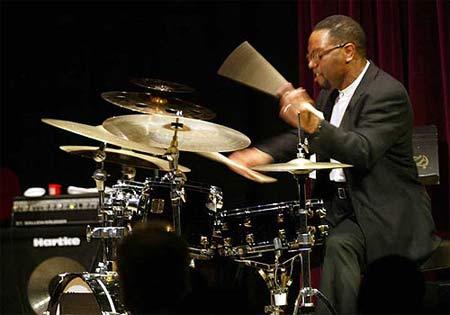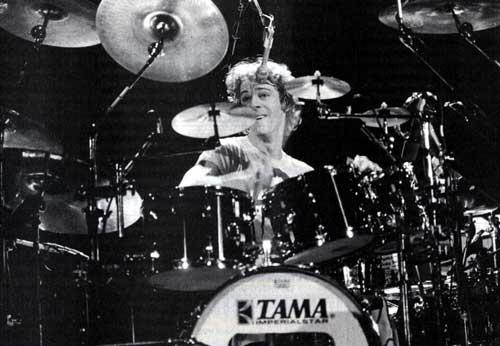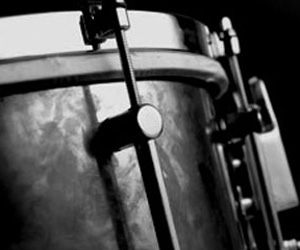Drum Tips - Drum Tuning
 Drum Tuning is a BIG Deal.
Drum Tuning is a BIG Deal.A well tuned drum sounds GREAT! A well tuned drum generally sounds better than a poorly tuned drum. Learning to tune your drums will make the engineer's job easier. You'll spend less time and less money getting a great drum sound in studio time when your recording or during sound check on stage. However, there is really no "right" way to tune a drum. What sounds good to me might not sound good to you. What sounds great in a rock band is might not sound so good in a jazz gig.
Your individual personality will dictate your choice of tone. Yet, no matter what you like, you should be in control of your drum sound. You should never be stuck with drums that don't sound great to you.
The problem is that tuning a drum can be complicated. There are many variables that contribute to the tone of a drum, including:
- Type of Drum Shell (Birch, Maple, Steel, Brass, Pressboard, Plastic, etc.)
- Size of the Drum Shell (Diameter and Depth)
- Type of Drum Head (Calf Skin, Kevlar, Mylar, Coated, Clear, etc.)
- Thickness of the Drum Head (Thin, Thick, Single Ply, Double Ply, Oil Filled, Pinstriped, etc.)
- Top Head Tension
- Bottom Head Tension
- Relationship Between the Tension of the Top and Bottom Heads
- Muffling
I have two different drum sets, and trying to tune them both the same way is possible but not easy. My Yamaha kit sounds great with the toms tuned low, pin striped heads on top with clear mylar heads on the bottom of each drum. I have the top head tuned to a pitch slightly lower than the pitch of the bottom head. The kit has a big fat, warm drum sound. My D’Amico kit on the other hand, sounds great with coated ambassador heads top and bottom, tuned basically to the same pitch. The toms are tuned pretty tight, high pitched. The D’Amico kit has a ton of ring and high end overtones and cuts through really well. The Yamaha kit just seems happier with the warm, round tones and the D’Amico kit is happier with the higher pitched, ringing tones. To me, they sound very different, but they both sound absolutely fabulous!!
Hopefully, some of the information here can help you get your drums sounding great – the way you want them to sound.
General Drum Tuning Tips:
Generally, any musical tone has only three qualities: 1) Pitch or Frequency, 2) Timbre or Harmonic Structure, and 3) Volume. When tuning a drum you will be adjusting these three qualities of the drums sound.Having good drums is a pre-requisite to a great drum sound. BUT! They do not have to be the best, most expensive set of drums available to produce a great sound. Every major drum manufacturer has a low price line (around $500) that are relatively well made drums which can be tuned to sound very good.
If you take the time to experiment with your drums, find out where they sound best, use good heads on them, and tune the heads with even tensioning – Then, even an inexpensive, old set of Pearl Exports can sound great!
There is a fabulous old instruction video by the great British session player Simon Phillips which has a great section on tuning drums. It has also recently come out on DVD and is available on amazon.com: http://www.amazon.com/Simon-Phillips-Complete/dp/0739040251
Even tensioning around the head is important to creating a consistent tone. Uneven tensioning can create inconsistent overtones or even buzzing sounds. But, uneven tensioning can also create interesting pitch changes or a dropping pitch bend sound during the decay of the drum tone.
Make sure the drum heads are sitting down tightly against the rim. If parts of the head are floating slightly above the rim instead of sitting down properly on the rim - it can dramatically alter the way the drum head vibrates. This can create uneven overtones, buzz, and can dramatically shorten the sustain of the drum.
Regarding Shell Size:
Shell size (diameter and depth) has a significant effect on the sound of a drum. It is generally much easier to create a low pitch tone on a larger diameter shell. The depth of a drum, distance from top to bottom, affects the sustain characteristics of the drums tone. This distance effects the pitch of a standing wave that can form inside the shell, a deeper shell can sustain a lower pitch standing wave and give that drum a lower pitch resonant frequency.However, there is a trade off with large drums in that the bigger the surface area of the drum head, the harder to keep enough tension for good playability.
Personally, I prefer smaller drums tuned low instead of larger drums. Small drums can actually sound very deep and big on tape or through the PA system. Small drums tuned low still maintain a small surface area that can rebound quickly and give a good feel to the playing surface.
I have also found that with smaller drums it is easier to tune a greater variety of tones between the toms. The lower pitch tuning of a small drum still maintains many of the higher frequency characteristics of the small drum itself and creates more cut, or projection of the sound. When I have had large drums tuned to the pitches that sound best for each drum, they did not project well into the audience. All the drums ended up sounding too similar to each other – they didn't stand out as individual drums in the mix and those great fills I had worked so hard to get clean ended up sounding more like muddy thunder than a fantastic fill across several toms.
Regarding Head Choice:
Generally, a thin drum head produces a longer sustain and more overtones than a thick drum head. A coated drum head has all those tiny little surface bumps to create more overtones than a clear drum head and provides a better surface for brush work. A two ply head will vibrate against itself and dampen the sustain and overtones to produce a warmer, rounder tone. Oil-filled (or hydraulic) drum heads may be impossible to find these days – they produce almost no overtones for a really damped, 1970’s studio tone.I generally have clear Remo Emperor heads on the top (two ply like a pinstrip without the strip) and clear Remo Ambassadors on the bottom of my toms.
Snare Drum Tuning:
A snare drum has a few unique characteristics that create additional challenges when trying to create a great drum sound. The snare drum is the heart of your drum set, often you’ll be playing the snare drum more than all the other drums combined.The snare drum is often the thinnest drum in your kit which means the interaction between the top and bottom heads will be different than on all the other drums. The bottom head is generally MUCH thinner than any other drum head on your kit and it has a bunch of brilliant little "rattles" rubbing against it. The bottom rim of your snare drum has a dip cut into the bearing edge for the snare to rest in which creates problems in getting even tensioning around the bottom head.
The snare drum can be the most sensitive drum in your kit. This means that very small changes in the tuning can create large changes to the sound of the drum.
As for head choice on the snare drum – well I'm generally an "old-school" kind of guy. I prefer a single ply medium weight batter head (Remo Ambassador Coated) and a very thin bottom head (Remo Diplomat Clear)
Snare Top (Batter) Head:
The variety of different sounds that can be pulled out of a well tuned snare are astounding! Generally:- Lower pitch = warmer, fatter, big, rock, backbeat sound.
- Higher pitch = tighter, cleaner, articulated, funk, jazz, intricate sticking sound.
Don’t be afraid to experiment. It is amazing how tight a snare drum can be tuned. Marching band and Scottish bagpipe band drummers generally tune the top snare head extremely tight. Such tight snare drum tuning provides lots of “bounce” which helps when playing really intricate sticking patterns, and the tight, clean tone of the drum allows such intricate sticking patterns to be heard. The sound doesn’t get too muddy to actually hear what the drummer is playing.
Be advised though, it IS possible to over tighten a drum head. You probably won’t damage the drum itself, but you can ruin a drum head if you put TOO much tension on it.

Stewart Copeland (of The Police – the band that Sting was in before some of you were born) used to tune the top head of his snare so tight that he often had problems with the tension destroying the head - actually pulling the head right out of it's reinforcing ring.
SnareBottom (Snare) Head:
The bottom bearing edge of a snare drum shell has a slight indentation where the snares cross the rim, this is called the “snare bed”. This helps keep the snare wires tight against the bottom head, but creates a bearing edge that is not perfectly flat. When the bearing edge is not perfectly flat, it is easy for the drum head to sit up off the edge of the shell a little. This can make it difficult to evenly tension the snare head and can cause little distortions and wrinkles in the snare head. Generally, such wrinkles can cause overtones and buzzing in the drum, but with the snare, you will be creating all kinds of overtones and buzzing by adding the snares. So it really isn’t as much of a problem as it might be on a tom where you want a nice clear tone.Again, the key is to experiment with the relative tension that works best for your drum. If the head is too tight, the snare won't seat as well into the snare beds and you might get a bit of a chocked snare sound.
Snare vibration is related to tension of the bottom head. The tighter the bottom snare head, then more the snares will vibrate – creating more of a nice "crack" sound. A looser bottom head creates less snare vibration and produces a softer "poof" tone.
Snare vibration is also affected by tension of the snares themselves. High tension, tight snares will shorten and intensify the buzz, while lower tension, looser snares will lengthen and soften the buzz of the snares.
Sympathetic vibration is when the snares buzz from the sound of a bass, keyboard or guitar note. Tuning the bottom head to the same relative pitch as the batter head can help "open up" the tone of the drum and increase resonance, but can lead to more sympathetic vibration.
Just remember to experiment a lot and listen for what sounds best with your particular drum.

